Official Name
Нови Сад (Novi Sad). The town is not very old and so there aren't any old names. The word 'sad' means 'garden' in many Slavic languages, so the name might mean New Garden (but I'm not sure if this is the real meaning of the name). In Austro-Hungarian times, the German name Neusatz was quite common, too.
Location
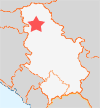
| ||
| Belgrade |
Novi Sad stretches along the left (northern) bank of the river Дунав (Dunav, Danube) right in the middle of the Pannonian Plain. The Serbian capital →Belgrade is around 70 km away to the south, border crossings to →Hungary, →Romania, →Bosnia as well as to →Croatia are less than 100 km away each. Until the abolition of the autonomy status of the Војводина (Vojvodina), Novi Sad was the capital of the province. The Vojvodina is characterised by its strong Hungarian minority - one quarter of the inhabitants are ethnic Hungarians.
Population
About 350,000 - Novi Sad is the second-largest town of Serbia.
Orientation
As already mentioned above, the town is relatively young. The historic centre dates back to the 18th and 19th century and stretches around Трг Слободе (Trg Slobode, trg=square). The square is only a few blocks (and a park) away from the river Danube. A nice pedestrian zone called Змај Јовина Zmaj Jovina starts right at the central square. The long main road бул. Михаила Пупина (Bulevar Mihajla Pupina) runs south of the square. Among several shops and department stores, you will find the very helpful and extremely friendly tourist information ((Mihalja Pupina 9) on the boulevard. The same road leads to the main bridge which will bring you straight to →Petrovaradin Citadel. The new and not really attractive main train station as well as large parts of the new districts are more than one kilometre away from the centre at the end of бул. Ослободженја (Bulevar Oslobodshenia) running to the north-west. Left of the train station there's the central bus station.
History
Older than the town itself is the large →Petrovaradin Citadel on the other side of the river. The citadel offered protection against potential invaders, and so first merchants and craftsmen settled on the left bank of the river Danube since the 17th century. After the liberation from the Ottoman yoke, Novi Sad and the area around the town belonged to the Austro-Hungarian Monarchy.
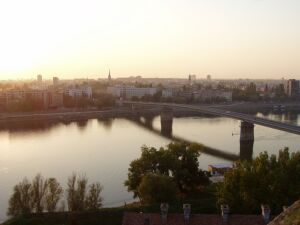
| ||
| General view of Novi Sad |
The citizens of Novi Sad purchased the present name as well as the status Free Royal Town from Vienna in 1748 for a substantial amount of money. Soon, Novi Sad became the main centre of the mostly rural Vojvodina. The town was characterised by its multiracial community: Serbs, Hungarians, Germans, Jews, →Slovakians, Ruthenians, Greeks, Armenians etc lived in town peacefully. After the defeat of the Monarchy in World War I, the Vojvodina was included in the newly founded Kingdom of Slovenians, Croats and Serbs respectively Yugoslavia. Novi Sad was declared capital of the province Danube Banovina, which was later renamed 'Vojvodina'.
Since there are several strategically important bridges as well as petrochemical and other industry in and around Novi Sad, the town became a target of NATO air raids during the Kosovo war. Novi Sad was particularly affected: Administration buildings and the TV station in the centre were bombed. Another attack destroyed wide parts of the petrochemical industry facilities, releasing tons of toxic substances. The destruction of the bridges did not just lead to a complete traffic collapse, but also to severe problems in the supply of drinking water to the civilians.
Getting there / transportation
The international express train (EC) from Vienna via →Győr and →Budapest to →Belgrade stops in Novi Sad, making it easy to get there. There are also several local trains to and from Belgrade as well as many buses serving national and international destinations. The local train to Belgrade nees around two hours, the fare is 135 Dinar (€ 2).
The daily EC to Vienna leaves shortly before 10 am and needs around 7 hrs to →Győr in Hungary (€ 30) and 10 hrs to Vienna. Buses seem to be slightly cheaper (to Budapest, the fare is 1,400 Dinar, € 20). Since the train and bus station are quite far away from the city centre, it's better to take a bus. Novi Sad has a wide and useful bus network.
The town is indeed not very old, so there aren't any historic highlights in town. However, the vibrant squares and streets in the centre create a pleasant atmosphere, making it a worthwhile destination. It's fun to simply walk around. Especially in summer: There are countless ice cream parlours, and the ice cream is really fantastic! Ever since, we referred to Novi Sad as the Ice Cream City. Additionally, there are some interesting museums. Among them, the Музеј Војводине (Muzej Vojvodine) on Dunavska 35 & 39 str., introducing history, craftsmanship, art etc. of the Vojvodina, is definitely worth mentioning. Admission fee is 20 Dinar for students.
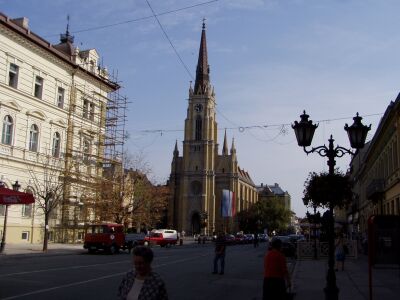
| ||
| Church at Trg Slobode, the centre of town |
Everything concentrates around the large church facing above-mentioned Трг Слободе (Trg Slobode). Countless modern bars, restaurants and shops line up along the streets around the square. Therefore, the square is always bustling with life. The church on the picture is called Roman-Catholic Church Maria's Name and was built at the end of the 19th century. The same can be said about many buildings close to the church.
When you walk from the centre along the main street бул. Михаила Пупина (Blvd. Mihajla Pupina) to the east, you will get to the so-called Главни Мост (Glavni Most, main bridge) after 15 minutes or so. The bridge spans the river Danube. There you will be offered this beautiful vista:
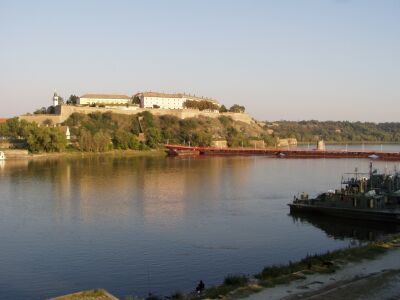
| ||
| Petrovaradin-Citadel at the right bank of the Danube |
On the right you will notice a makeshift pontoon bridge and further to the south large stone bridge piers of the old Varadin Bridge. Within the city limits, not less than four bridges spanned the river Danube. All of them were destroyed during the air strikes carried out by the NATO. Two bridges have been rebuilt, one was substituted by the above-mentioned makeshift, another one can be found further to the south - it was a large, modern motorway bridge. Only half of that bridge has been left.
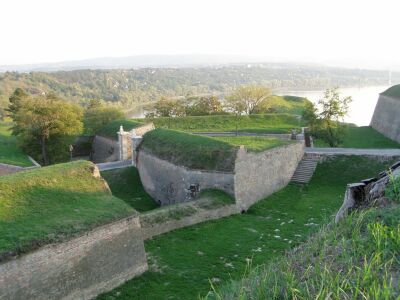
| ||
| Inside the old Habsburg citadel Petrovaradin |
The large citadel Петроварадинска тврђава (Petrovaradinska Tvrđava), formerly known under its German name Peterwardein, was built between 1699 and 1780 on behalf of Maria Theresa, queen of Habsburg ruled Austria-Hungary. The French citadel specialist Vauban planned the fortress. The citadel towers above the river and the town on the top of a steep hill. The old and very scenic town at the foot of the hill has a distinctive Habsburg flair. From there, a steep and long stairway leads to the citadel itself. Inside, there are some old apartment blocks which are under reconstruction (as of 2003). There's also a church inside the citadel. Unfortunately, wide parts of the fortress have been levelled, but the dimension of the fortress is still obvious and very impressive. The hill marks the northernmost part of the Фрушка Гора Fruška Gora (gora=mountains) - with a maximum altitude of 539 metre by far the highest point of the Vojvodina. The rest is completely flat.
There seem to be other interesting places lining up along the Danube - the tourist information in Novi Sad has plenty of material about that.
There aren't any cheaper hotels or hostels in the centre of town. The large hotel opposite the train station is quite expensive. The tourist information sent us to the old and beautiful Хотел Војводина (Hotel Vojvodina) right at central Трг Слободе (Trg Slobode). A large double with a bathroom costs 2,600 Dinar (€ 40, incl. breakfast). According to the staff at the tourist information, other places charge the same or more. However, the location is just perfect. The price includes pets - tiny cockroaches. Must be something compulsory in Serbia - the same we had in Belgrade. Maybe a room without them is even cheaper!? Here's the address: Trg Slobode 2, Tel: 622 122, Fax: 615 445.
- www.visitnovisad.co.yu Novi Sad does a lot to promote the town: Here's the proof: A nice and very informative official website. English and other languages available.
- www.geocities.com/TheTropics/Paradise/3594/Novi_Sad/NoviD.html Several pictures showing the damage done by NATO air raids in Novi Sad.
Do you have or do you know a good website about Novi Sad? Don't hesitate, let me know! After checking it, I would love to add it to the link list. You can submit a link by using the →contact form. Note that commercial websites will be treated differently.
©2024 Europe-East.com

 Albania
Albania Serbia
Serbia